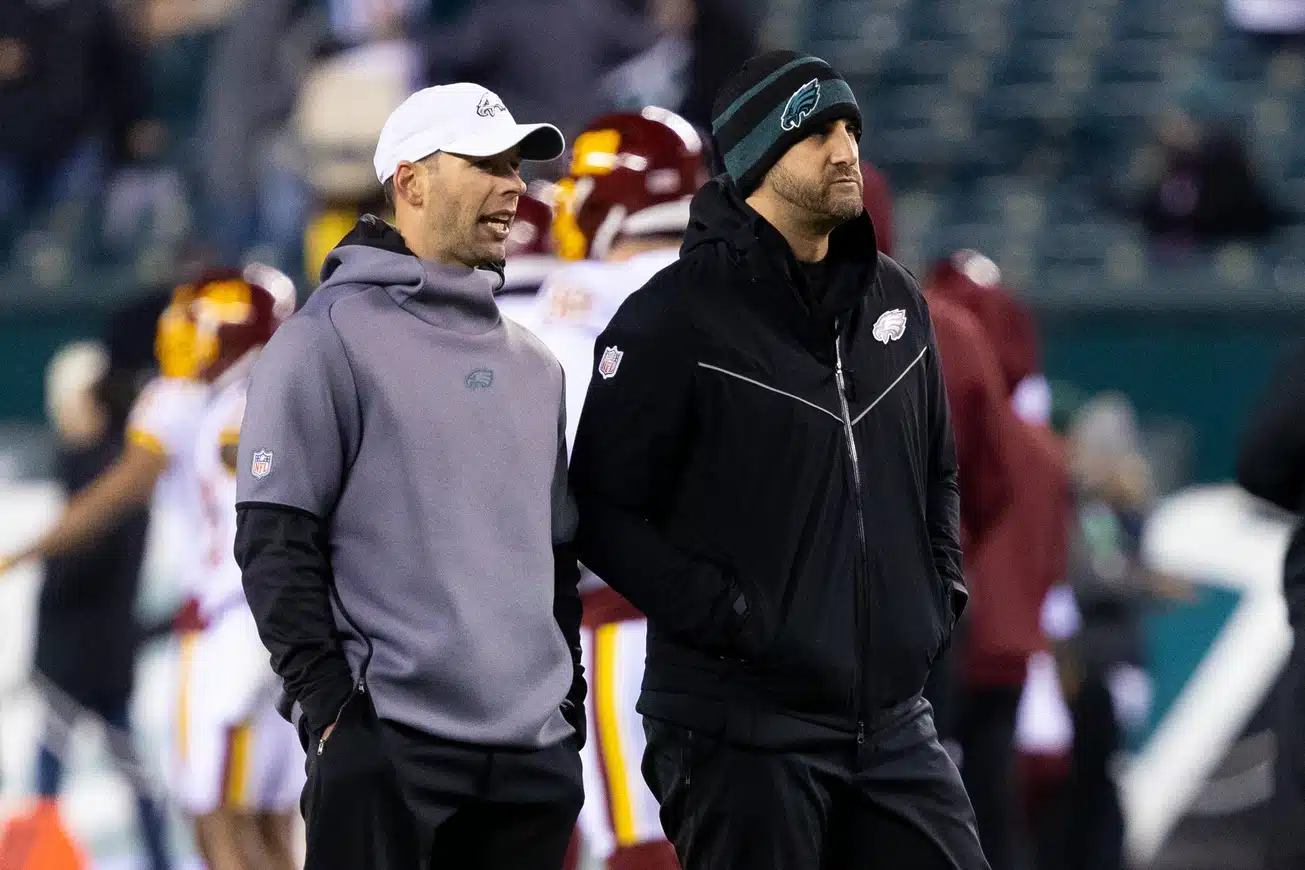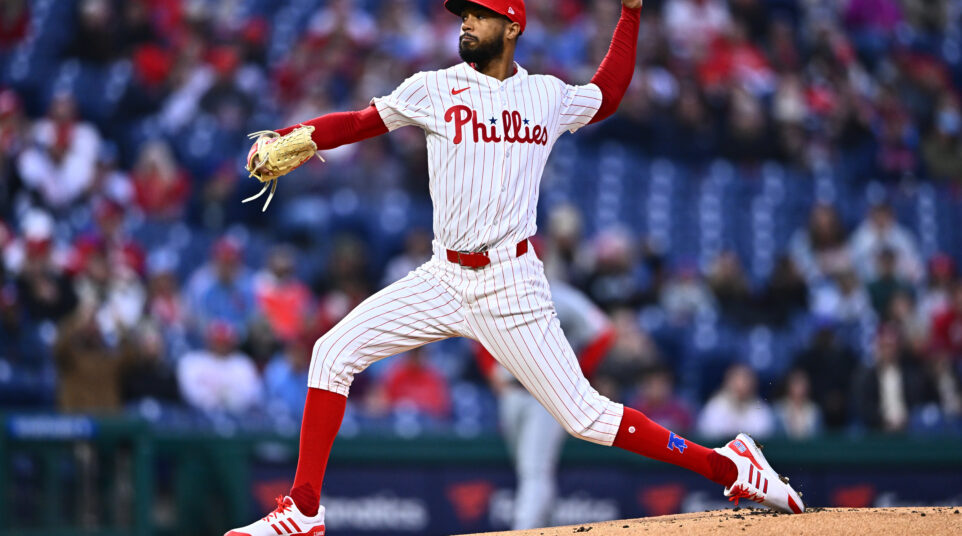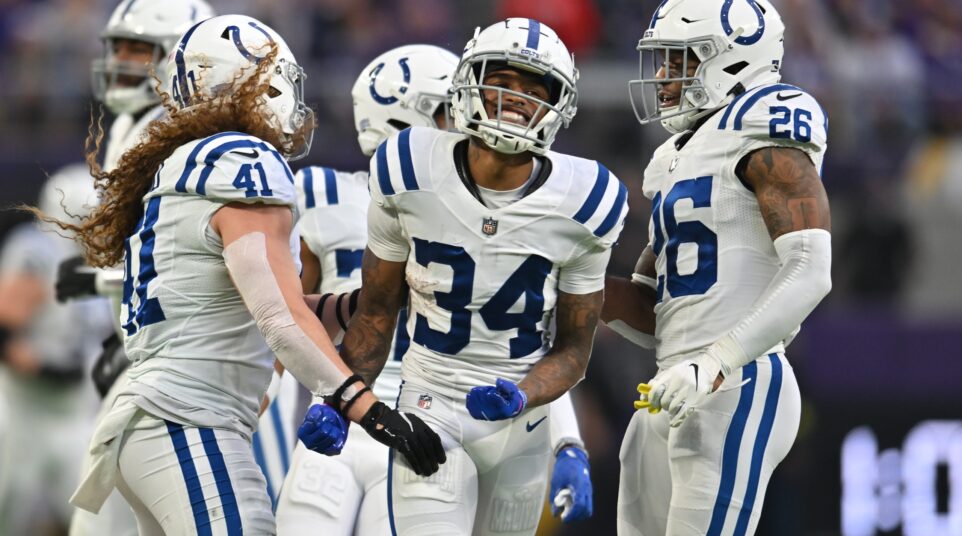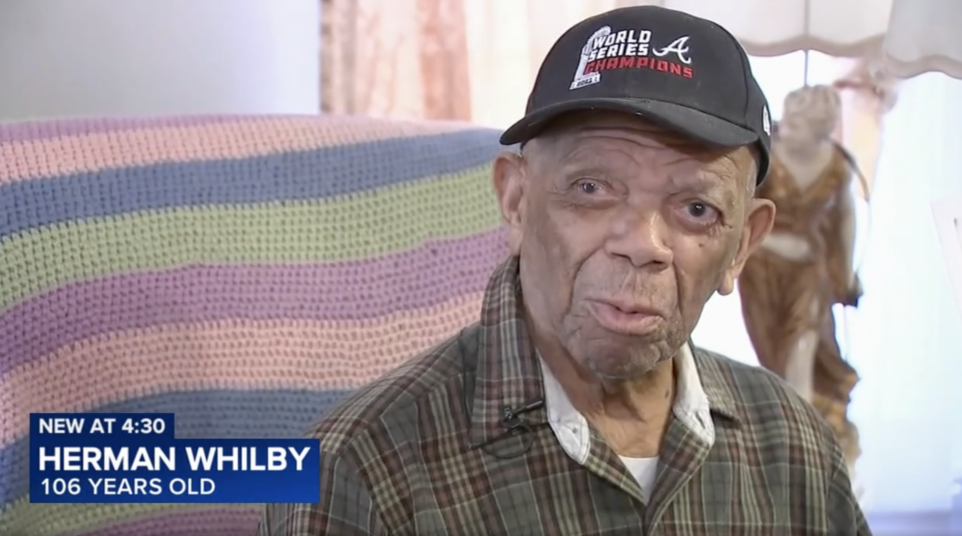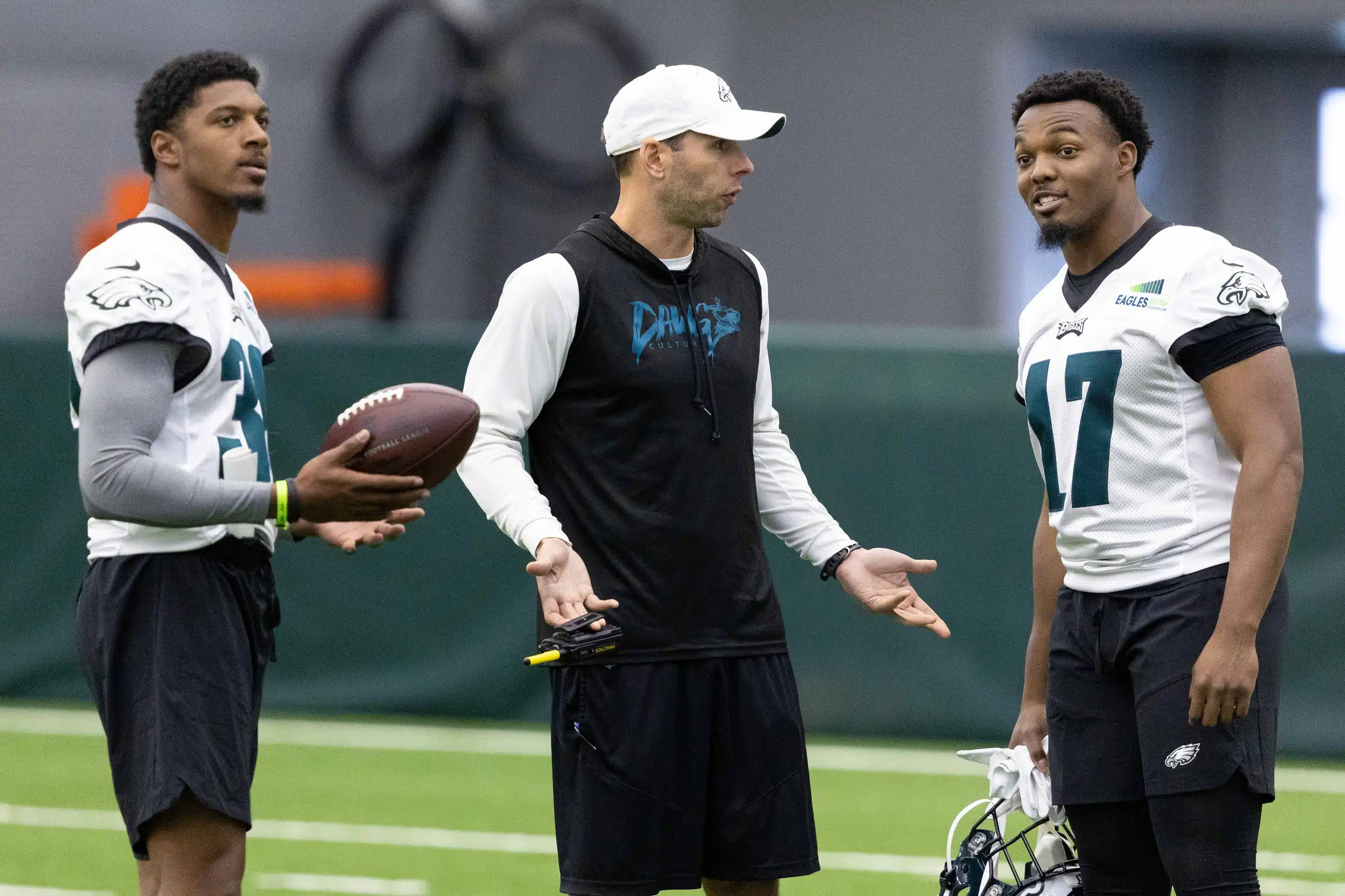
A Fair and Balanced Response to Every Single Jonathan Gannon Criticism
The Eagles are 14-3 and the #1 seed in the NFC with a first round bye. This was one of the best Birds regular seasons of all time, yet a portion of fans hate Jonathan Gannon’s guts and spent endless time and energy complaining about the defensive coordinator all year long.
We’ve largely defended Gannon this season on the website and Crossing Broadcast, not necessarily because we’re Gannon lovers, but because the criticism the guy receives is incredibly over the top. This is not QGannon. Nobody is saying he’s the second coming of Dick LeBeau, but people talk about this guy like he’s a poor man’s Juan Castillo, which is absurd.
As an exercise, we’ve invited Gannon critics to present us with a comprehensive list of complaints, which are answered in a fair and balanced manner:
“they didn’t play any good quarterbacks”
This is the strongest argument the Gannon haters have. The best quarterbacks were in the AFC this season, so the Birds didn’t face Patrick Mahomes, Joe Burrow, Josh Allen, or Justin Herbert. You can even throw Tua and his weapons in there as well.
Their best wins were against Aaron Rodgers and Kirk Cousins, then they beat Daniel Jones, Kyler Murray, and Jared Goff on the road. Throw in home wins against Trevor Lawrence and Ryan Tannehill. Otherwise, they faced Davis Webb, Andy Dalton, Justin Fields, Matt Ryan, Carson Wentz, Taylor Heinicke, Cooper Rush, Davis Mills, and Kenny Pickett.
“crap quarterbacks completing 80% of their passes”
A chart:
How about an awful trend in completion% allowed by his def in the second half? Not even talking about the historically bad (record setting) stats from last year. It’s almost like when the offense was less consistent later year, his def couldn’t just pin their ears back pic.twitter.com/btDK1TaHsF
— BCB JR (@WanderingBear86) January 9, 2023
Just like last year, this is a product of the system. They simply seem to be okay with allowing soft stuff at the expense of getting beat over the top, and to their credit, they allowed the second-fewest plays of 20+ yards this year. It’s a philosophical tradeoff that can be frustrating, but kept points off the board in a bend-but-don’t break fashion. They allowed the opponent into the red zone at a top-10 rate, but 55 red zone drives ended with 15 field goals and 29 touchdowns, which were bottom and middle portion stats. They were #1 in the league in red zone interceptions and #4 in disallowing red zone points entirely. On 20% of opponent red zone forays, they came away with nothing at all.
The bigger issue is harder to parse, which is the idea of letting quarterbacks find a rhythm. Your biggest playoff concern, and mine, is someone like Dak or Brady getting into a flow and dinking and dunking down the field, chewing up clock and controlling the game, gaining confidence in the process. That’s when Gannon needs to be quicker to deviate and send pressure, play press man, or bracket specific receivers. If he sits in Cover 2 while Brock fucking Purdy throws check downs for nine whole minutes, then I’ll jump off the bridge with you.
“the defense is only good because of the players”
No shit. Every scheme looks better with good players. Buddy Ryan had Clyde Simmons, Reggie White, Seth Joyner, Eric Allen, Jerome Brown, Wes Hopkins, etc. He wasn’t running the 46 defense with scrubs (and even then, Bud Carson took Buddy’s players and reached the pinnacle in 1991). Jim Johnson had Brian Dawkins, Jeremiah Trotter, and boatloads of Pro Bowlers.
The extended version of this argument is that Gannon…
“…didn’t maximize player strengths”
It’s a little tough when different guys have different strengths. Fans and media seem to agree that Darius Slay is better in man and James Bradberry in zone, so what’s the play there? Man or zone? One guy ended up in the Pro Bowl and the other is an alternate, so I’d say it worked out for them.
For what it’s worth, Haason Reddick had a career year and was dropped into coverage only 63 times, which was an all-time low, so credit both the player and coordinator there. Javon Hargrave was a Pro Bowl snub while Fletcher Cox, Brandon Graham, and Josh Sweat were named alternates. I’m trying to think of a defensive player who was under-utilized or under-performed on the limitations of the scheme, and nothing really jumps to mind. There were certainly times when Josiah Scott struggled or Kyzir White was left on a coverage island, but six of the 11 starters in nickel were named Pro Bowl players or alternates, so that’s pretty damn good.
“not good enough on third down”
38.6% opponent third down conversion rate. They were 14th, so right near the middle. As good as they were in every other statistical category, you’d think this number would be a little better.
“they don’t blitz enough”
The Sport Radar/PFF data says they blitzed on 21.9% of snaps, which was 18th-most in the NFL. That’s also in the middle.
For context, Wink Martindale’s Giants led the league with a 37.6% blitz rate, and the Jets were 32nd at 14.6%. In order for the Eagles to enter the top ten, their blitz rate would have had to land at 30%.
“not enough pressure on the quarterback”
This one is undeniably fake news. Despite blitzing at that 21.9% rate, they finished #1 in sacks, #2 in QB hits, and #12 in hurries. When you combine the numbers, they finished #1 in “defensive pressure percentage,” logging a sack, hit, or hurry on 24.8% of their defensive snaps.
“bad starts/not good enough on opening drive”
This is one is 100% true. While opposing offenses are typically scripting their opening drives, and difficult to predict/defend, the Eagles allowed 84 first quarter points, which was 5th-most in the NFL.
In fact, the defensive differentials were all over the place. They were top five in the 2nd and 3rd quarter and bottom five in the 1st and 4th quarters. Too many crap early touchdowns and crap late/garbage time touchdowns to book-end what were mostly suffocating middle portions of the game. The defense had high highs and low lows with variation throughout most games.
“he’s too slow to adjust”
This one is hard to write about because it’s heavily subjective and requires hours of film study. The pattern, however, suggests that the Eagles start in a conservative fashion, see what the offense is throwing at them, and then make their tweaks from there. They’ll typically start soft and then tighten up before pulling back to protect a lead, which the quarter point differentials seem to support.
There’s also a bit of quirkiness in the way Gannon backs off when a play doesn’t go their way. The best example of this is when Avonte Maddox got to Dak Prescott on the 2nd drive of the Dallas road game but couldn’t bring him down. Gannon then took his foot off the gas and went rush 4/drop 7 on the next 5-6 plays, getting totally chewed up in the process.
Largely, he’ll made tweaks in coverage (bracket a slot guy, shift help) while still adhering to the system. He’s not abandoning the entire game plan to call zero blitz and roll a single-high safety. Maybe people are looking for that, but a significant departure in that mindset probably isn’t going to happen. He’s still going to try to keep everything in front.
“he wears that weird backwards-sweatshirt thing”
Valid gripe here. I don’t get the snood-esque look. It’s like if Kanye West designed a mock turtleneck for the extras in a Star Trek movie. At least when Belichick wears the sleeveless hoodie, he cuts off the arms and goes with a rugged blue collar “football guy” look. This is too polished:
Bill Streicher-USA TODAY Sports
“he plays too much zone”
This is the hardest one to answer for a variety of reasons, but note that Nick Sirianni came out a few weeks ago and disputed the idea Gannon was only playing pure zone. This was what he said in response to that Sheil Kapadia stat about Dak Prescott going 24-24 against zone:
“I think all zones are a little different, right? I mean, some match zones are going to play out like man and be labeled as a zone as far as the way they (appear on film). Cover three really you can play multiple different ways. You can play a zone; you can play a true zone; you can play a match zone; a match zone on one side; a zone on the other with the safety cheated to the other side; you can play it with zone all the way across with the corners playing man. There are a lot of different variations of that zone that could be played, and then obviously that’s the same thing in cover two, same thing in cover four.
I think just looking at that stat in that world is, ‘hey, we didn’t coach good enough and play good enough,’ and that’s why it was 24-24, not necessarily that it was zone, because, again, some zones play out like man anyway and all the zones are a little bit different.”
Right off the bat there’s ambiguity, so the best we can do is defer to the experts and let them go to work identifying man, zone, match/zone, split zone, and whatever other iteration of defensive coverage exists.
According to Sports Info Solutions, the Eagles:
- rank 29th in man coverage usage
- rank 8th in zone coverage usage
They play much more zone than man, which we already knew from using our eyeballs.
Beyond those basic rankings, the SIS data says opponent EPA (expected points added) against the Eagles zone snaps is 9th overall, while their EPA against man is 31st. One number we really need, and can’t seem to find, is completion percentage against the Eagles’ man vs. completion percentage against the Eagles’ zone, plus the raw amount of snaps in each, so I’ll keep sniffing around to see if that data exists somewhere. It would really help build out this portion of the article.
EDIT – looks like I had the SIS data backwards actually. Opponent EPA is 31st in man and 9th in zone, so they were much better in expected points added when playing zone than playing man. Zone = good, man = not good. Lemme keep digging here and I’ll add what I can.
For added context, Pro Football Focus sometimes does a weekly a story about zone and man, and they logged the Eagles with a 27.3% man coverage rate after week 11, which means they sat in zone a little more than 72% of the time. Most teams were in the 20-30% man range, so league-wide, it’s very common for coordinators to play 60-80% zone. Likewise, Jalen Hurts and the Eagles’ offense faced zone about 69% of the time this year and man about 31%. There were obvious fluctuations based on opponent and the game plan.
You could certainly make an argument that the Eagles should play more man, though when you look at league-wide trends, zone is very common and you see almost twice as much of it than man. The top man-to-man teams this year include the Giants, Patriots, and Lions, all of whom finished top-12 in defensive pressure percentage, but behind the Eagles, who ranked #1. It would seem as though zone is very much in fashion to limit the high-powered and popular passing attacks of the modern-day NFL.
“the offense gave him big leads, which allowed him to be conservative”
It’s certainly true that they jumped out to multi-score leads in a number of games, notably the first Dallas win, the Green Bay game, and the Lions season opener, which then became needlessly competitive. Sometimes, though, the leads were because the defense was playing well, like when they terrorized Carson Wentz and shut down Justin Jefferson in consecutive weeks. The offense also had a poor second-half differential early on while doing a ton of damage in the 2nd quarter. Then there’s the Indy and New Orleans games, where the defense was the only reason the Birds were competitive at all.
The answer here I think is mostly a wash. The truly bad games the defense played were Detroit, home vs. Washington, the Dallas loss, and then portions of Green Bay. There were rough moments in a number of outings, but I don’t think the defense was truly “bad” outside of maybe 3.5 games. In 12-13 games this year, the defense was sufficient enough to win.
What did we learn?
The overarching theme with Jonathan Gannon’s 2022 defense is that it did largely what it was designed to do, which is prevent big plays and limit damage in the passing game. The fact that the Eagles were able to get to the quarterback as much as they did while only blitzing at a middle-of-the-pack rate and playing a lot of zone resulted in a balance that prevented chunk plays while oftentimes moving the QB off his spot with just a four-man rush. If you can get to the QB with four, do you need to send six? A rhetorical question.
Statistically, they finished top 10 or top 5 in most major categories and only lagged behind in a few areas, more or less by design.
My thought is that people seem to conflate the idea of personal preference with Jonathan Gannon being a bad coordinator. His scheme is conservative and typically bends without breaking. If you disagree with that philosophy and would rather see someone like a Wink Martindale run the Birds’ defense, that’s perfectly fine, but it doesn’t mean that Gannon is “terrible,” it just means you like a different style and a more aggressive approach. Philadelphia Eagles fans largely seem to gravitate to smash mouth defense ala Buddy Ryan and Jim Johnson, and that’s become a significant part of the ecosystem in these parts over several decades now. Remember, fans had the same exact complaints about Super Bowl winner Jim Schwartz, who played too much “off” coverage and didn’t blitz enough. It’s an easily identifiable pattern.
Anyway, I hope you found this to be a fair and balanced blog post.


